The U.S.S. Oregon

"The Bulldog of the Navy"
Source: Jeffrey H. Meals' U.S.S. Oregon site
For the more famous Pre-Dreadnoughts, some bits & pieces were preserved when the ships were torn apart. Pubic interest in old warships generally revived when news of their upcoming dismemberment was announced.
Masts, guns, anchors, and other elements of some Pre-Dreadnoughts have been preserved and are on public display. This page highlights just a few of these relics saved from the scrapyards. If you know of more such preserved bits & pieces of Pre-Dreadnoughts around the world (and preferably with some Internet-based information on them), please e-mail me with the information at [email protected].

I read a little pamphlet on the Oregon from the Oregon Historical Society and learned the history of the ship, it's short retirement as a floating museum in Portland, and its final destruction. That some parts of it remained as reminders of its existence added to an already growing fascination for the ship named after my home state.
Here is an excellent picture of the U.S.S. Oregon Memorial in Waterfront Park in Portland from Jeffrey H. Meals' U.S.S. Oregon web site. A close-up photo of the bow shield is also shown. Not far from the Memorial in downtown Portland are the U.S.S. Oregon's two preserved smoke stacks.
For very complete information on the U.S.S. Oregon, visit Jeffrey H. Meals' U.S.S. Oregon web site. Jeff has done a simply outstanding job of memorializing the ship with excellent information on all aspects of the U.S.S. Oregon, its operational history, crew, and technical specifications. Of particular interest is Jeff's Photographs Gallery page with links to pictures of the Oregon in service and of remaining artifacts from the Oregon.
See also A Chronicle of the Battleship Oregon by Ken Lomax from the Oregon Historical Quarterly.
The Iowa Class Preservation Association has an excellent web site on the Battle of Santiago de Cuba in which the Oregon participated. It includes battle maps, a detailed account of the battle, and a graphic comparison of the American and Spanish squadrons. The Spanish American War Centennial site also has a page on the Battle. They also host an interesting diary kept by one of the firemen on board the Oregon during it's fateful voyage. A few pieces of two of the Oregon's opponents, the Infanta Maria Teresa and the Almirante Oqendo survive to this day as well. Another of the Oregon's opponents, the Crist�bal Col�n is a rusting wreck under the waves of the south coast of Cuba. See also the United States Naval and Shipbuilding Museum's web page on the Battle of Santiago - Spanish Wrecks After the Battle for pictures of the damage the Oregon helped inflict.
See also Aaron Hamilton's diagram of the Battle of Santiago de Cuba with side-by-side comparisons of the two squadrons' ships.
The Spanish American War Centennial site has web pages dedicated to the U.S.S. Oregon. Additionally, the Naval Historical Center has an excellent web site on the Oregon including lots of other photographs. A close-up of one her turrets is also online at the Naval Surface Warfare Center. There are also photos of the Oregon at the Battleship Photo Archive.
The Oregon's "sister ship", the U.S.S. Massachussets is now an underwater preserve off of Pensacola, Florida. These two vessels plus their class namesake, the Indiana, were built at different shipyards and are not completely identical.
There is also a good book available about the Oregon.
And finally, possible proof that the Oregon is still afloat - at least in the hearts of her admirers.
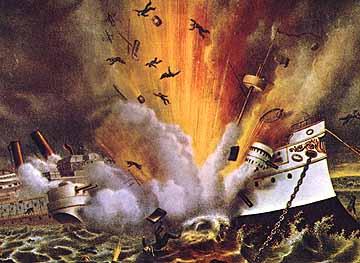
The Maine's main fighting mast, anchor, and other equipment were removed from the wreckage in Havana and has been placed in Arlington National Cemetery as a memorial to those who lost their lives on the Maine. This picture of the mast is from a website about the Arlington National Cemetery.
The mizzen mast of the Maine is located at the United States Naval Academy.
For futher information regarding the U.S.S. Maine, visit the Spanish-American War Centential site on the Maine. This site includes Patrick McSherry's outstanding page on the Maine's last resting places. Bits of the Maine, down to Captain Sigsbee's bathtub have been located in various venues.
The Maine's port anchor is on display at a public part in Reading, Pennsylvania.
More information on the U.S.S. Maine along with a list of its remnants may be found at Joel W. Eastman's Remember the Maine page.
Also see the Naval Historical Center which has an excellent web site on the Maine including lots of photographs. Additional photos of the Maine can be found at the Battleship Photo Archive.
An interesting line drawing plan of the ship shows her under full sail.
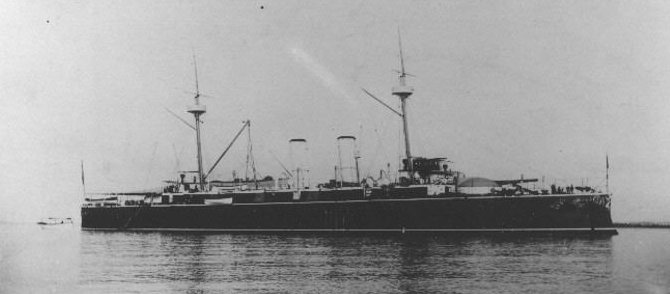
Sister ship to the Infanta Maria Teresa, one of the Almirante Oquendo's 5.5-inch Hontoria guns was also preserved as a war trophy from the Battle of Santiago de Cuba. Now on display in a Park in Palmyra, New York, pictures of the gun from the Almirante Oquendo as it currently appears may be found at the Spanish American War Centennial Web Site Be sure to also visit the Chart of Hits made on the Almirante Oquendo during the Battle.
Visit Shipwreck Central to view some awesome dive clips from the Almirante Oquendo and her sister ships Vizcaya and Crist�bal Col�n. From the front page, click on the Interactive Shipwreck Map. Then, in the "Enter Search Criteria" Ship Name box, enter " Almirante Oquendo" or "Christobol Colon" (sic) or "Vizcaya" to view brief video clips of these wrecks. Hover your cursor over the dive flag shown on the map and then click on the ship name shown by your cursor. You can view the "Wrecks of the Spanish American War" dive clip directly. I believe it primarly shows a dive on the Almirante Oquendo. A complete video tape or DVD of "Wrecks of the Spanish American War" can be purchased at Shipwreck Central's online store.
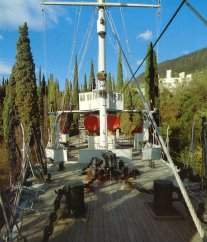
The Pulgia was a protected cruiser launched in 1898 and completed in 1901. She was used as a minelayer during Great War and was retired from service in 1923.
On the grounds of the poet Gabriele d'Annunzio's villa "Vittoriale" near Lake Garda in Italy, the Puglia's bow section was a gift of the Italian Navy to the poet. The section was dismantled and loaded on twenty railway trucks, taken to the Vittoriale and reconstructed so that its prow pointed in the direction of the Adriatic.
Apparently, the poet d'Annunzio was a favorite of the Italian naval service and served in the Great War. The motor torpedo boat MAS 96 is also preserved on the grounds of Vittoriale. The poet had some exploits on this vessel during the Great War.
Thanks go to Aris Bilalis for information on the Puglia's operational history and to Mark Kindrachuk for translating the following:
"Here is the history of the Puglia as recounted in Gli Incrociatori Italiani (Rome, 1971). The translation is mine, as are any infelicities in expression:
Puglia was the first ship built at the Taranto Arsenal. On 23 March 1901 she began her first commission, sailing to Naples and La Spezia. On 3 June, under the command of Capitano di Fregata Andrea Canale, she left La Spezia for Australia and the Far East. After visiting ports in Australia and Tasmania, the Puglia joined the Oceanic Naval Force ("Forza Navale Oceanica") in the waters off Woosung.
For almost a year the ship undertook various missions along the coast of China, Korea and Japan. On 19 November 1902 she received orders to return to Italy and left Hong Kong to return by way of Singapore, Colombo, Aden, Alula and Port Said, arriving at La Spezia on 7 January 1903.
In July 1903, under the command of Capitano di Fregata Ulrico Pescetto, the Puglia was sent to Central America and the Antilles in support of Italian diplomatic authority and to protect the interests of Italian nationals. After having visited the Antilles, in September-October the cruiser sailed along the coast of Brazil and La Plata. On 8 November she passed through the Straits of Magellan and continued up the west coast of South America. She reached Callao on 22 December 1903 and received orders to proceed to San Francisco, Honolulu and Yokohama to join the Oceanic Division ("Divisione Oceanica") at Shanghai.
As part of the Division, the Puglia spent some time in the waters of Chemulpo, crossed the Sea of Japan and passed through the Korean Straits, and then returned to Italy via Singapore, Colombo and Massaua, reaching Taranto on 15 June 1905 to end two years in foreign waters.
After repairs and refitting, the cruiser left for a new mission in America on 16 December 1907. After having been stationed in South American waters, on 15 October 1908 she left to serve as station ship in China, sailing through the Panama Canal and via San Francisco and Honolulu to reach Yokohama on 17 November. After visiting Kobe and Nagasaki, the cruiser anchored at Shanghai on 22 March 1909. She was replaced at Shanghai on 28 December by the cruiser Calabria, and after a brief voyage along the east coast of Africa, reached Taranto on 6 April 1910.
The Puglia, under Capitano di Fregata Pio Lobetti Bodoni, was sent to the Red Sea on 2 August 1911. The Italo-Turkish War found the Puglia in the Red Sea. On 3 November 1911, she sank the Turkish gunboat Alish at Aqaba. In December, she maintained surveillance of the enemy coast and escorted Italian transports. In January 1912 the Puglia bombarded Turkish troop concentrations at Jubbana and intercepted enemy merchant ships. She cut the Jedda-Suakim telegraph cable, bombarded Fort Warner and captured several Turkish sailing vessels. The Puglia returned to Taranto on 23 December 1912.
On 30 August 1914 the Puglia was transferred to headquarters command and reclassified as a minelayer.
During the 1915-1918 war, the Puglia was part of the Millo Division (Vice Admiral Enrico Millo) from 3 June 1915 to 17 November 1916, undertaking numerous missions in the Adriatic for the laying of offensive and defensive mine barrages. She returned to Brindisi and La Spezia for maintenance in January 1917. On 9 January she was placed under the disposition of the Supreme Naval Command in Libya. After reaching Libya, she patrolled the Libyan coast until 9 October, when she returned to Taranto for repairs. On 21 April 1918 she was transferred to the Battle Squadron and laid mines in the Straits of Otranto.
At the end of the war, the Puglia was assigned to the Dalmatian Naval Command in Sebenico. On 15 November 1918 she raised the flag of Vice Admiral Millo, then commander of the naval forces in Dalmatia. On 12 January 1919 the Puglia left Sebenico and took up duty as station ship in Spalato. Serious fighting between the Yugoslav and Italian inhabitants of Spalato broke out on the evening of 11 July 1920. In the course of the disturbances, the Puglia's commander, Capitano di Corvetta Tomasso Gulli, was killed. Commandante Gulli was posthumously awarded the Medaglia d'Oro al Valor Militare for his heroic conduct.
The Puglia remained at Spalato until 28 May 1921, when she returned to La Spezia. On 31 June 1921 she was transferred to Livorno to make her available for conversion into a minelayer. However, she returned to La Spezia on 14 March 1923 and was struck off strength on 22 March.
When the Puglia, which had played such a strong role in the support of Italian interests in Dalmatia, was destined for scrapping, it was decided that her bow section, including the bridge, should be donated to the soldier-poet Gabriele d'Annunzio. The relics, including her battle flag, were handed over with due solemnity, as is indicated by a telegram from the Ministry of Marine to the Commanding Officer at La Spezia:
Please ensure that the battle flag of the R.N. Puglia is delivered to Commandante d'Annunzio on the morning of the second. The flag is to be delivered by a delegation comprising an admiral, a senior officer and a junior officer selected by you. Please confirm. Mussolini"."
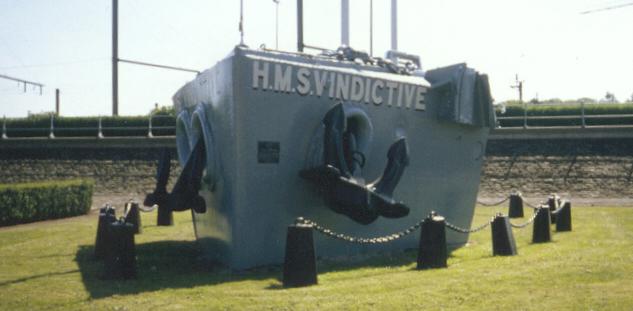
Famous for her action in the Zeebrugge Raid of 1918, the light crusier H.M.S. Vindicitive'sbow section has been preserved in Ostende, Belguim as a memorial.
Be sure to visit Colin McKenzie's fine memorial page to his great uncle Albert who participated in the Raid and won the Victoria Cross for his efforts.
There is some tourist information about the memorial in Ostende.
From Steve Johnson's page on Steam Ironclads, an excellent bow shot of the Vindicitive in 1902.
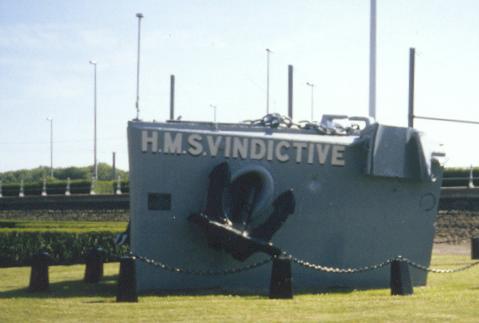
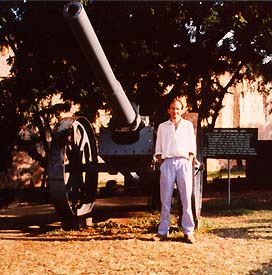
One of the more difficult of the Kaiser's commerce raiders for the Royal Navy to bring to heel, the K�nigsberg led the RN on a merry chase until finally cornered in the Rufiji river in East Africa. The attacks which destroyed the K�nigsberg are very interesting for their use of aircraft fire control on the part of the British to direct the shelling their unseen enemey.
See James Burbeck's excellent The last voyage of the K�nigsberg article in the War Times Journal for a detailed description of the K�nigsberg's career and destruction. See also K�nigsberg: A German East African Raider from Trenches on the Web.
The K�nigsberg's two 10.5 cm guns were salvaged by her German crew and placed on gun carriages. These guns were used to carry on the defense of the German colony in East Africa until the end of the Great War. The picture above shows one of the guns in Mombasa, Kenya (ironically positioned near a salvaged gun on one of K�nigsberg's victims, H.M.S. Pegasus). The other gun is said to be in Pretoria, South Africa. If anyone has web-based photos of this other gun in Pretoria, please inform me by sending e-mail to [email protected] .
Return to the Pre-Dreadnought Preservation main page.